Orthodox Easter is April 15th, and in Georgia, most places take off four or five days for vacation. In typical Georgian fashion, we didn’t know for sure how many days we had off until a couple of weeks before the break came up, but fortunately that was time enough to find out where some of the other TLGers in Kutaisi were going and tag along with them.
Our group consisted mostly of TLGers and embassy staff from Tbilisi, friends of my friends in Kutaisi who came out at the same time last year. For 300 GEL (about $185 USD), we got a private marshrutka and tour guide for four days, 3- and 4-star hotels each night, breakfast and dinner, and tickets to some of the more interesting sights between Reza and Trabzon. Multiple entry visas were $20 USD each, and the exchange rate in Turkey was quite favorable.
We met up at the McDonalds on Tchavtchavadze Street at noon and went up to see Motsameta Monastery. In spite of the fact that it’s so close to Kutaisi, this was my first time going up there, and I must say I was quite impressed! The monastery is situated on the top of an imposing cliff where the Tsqaltsiteli River makes a sharp bend. The English translation of the river is “red water,” named for the two Christian martyrs who were executed on the site of the monastery by the Muslims shortly after their conquest of the region.
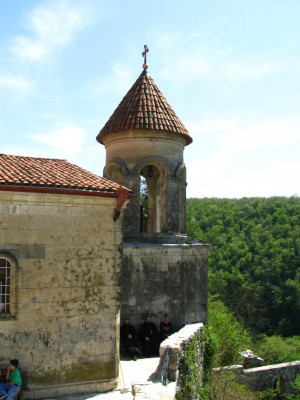
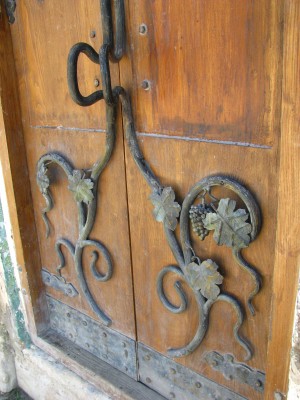
I spent most of the vacation relaxing, so I didn’t take many spectacular photos. But Motsameta was really fantastic–I’ll have to go back sometime to do it justice. There’s a forest trail that goes between Motsameta and Gelati Monastery, where David the Builder is buried, and I’d like to hike that before I come back to the states.
Next, we drove down to Batumi on the Black Sea, where we spent some time wandering the Botanical Gardens. It’s a really nice place, with trees and plants from all over the world right up against the seashore. Very peaceful. It’s pretty big, though–I walked for almost an hour along the main road without getting to the end. And of course, there are many places along the way where you can stop and wander around for a while.
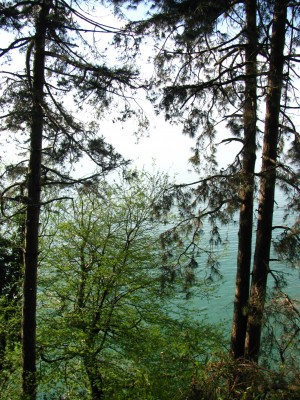
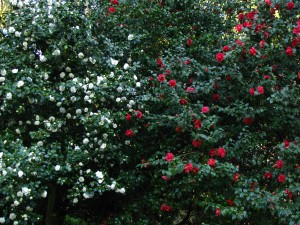
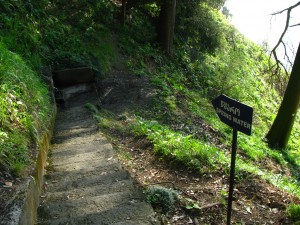
Batumi is an interesting place–not as big a city as Kutaisi, but with more money, hotels, casinos, and resorts. It’s right on the Black Sea, but the snow-capped mountains of the Lesser Caucasus range are right behind it, so you’ve got a big mix of climates and landscapes all within a short drive.
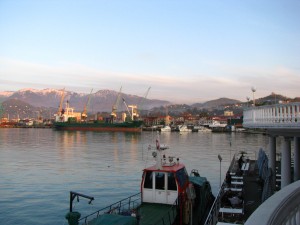
The other TLGers were impressed to see that the roads are actually paved–apparently, there’s been a lot of construction in the past year or so. It’s not completely finished, but walking around downtown is quite pleasant. We hunted for ice cream and eventually settled on a smoke-filled cafe on some random street corner. Good times.
We spent the next morning crossing the border, a process that was surprisingly disorganized. The system on the Georgian side was pretty straightforward, but on the Turkish side we had to wait on the curb for a long time, with giant eighteen-wheelers driving past us and the sun beating down. It wasn’t too bad, though–definitely not worse than the Allenby crossing.
We drove for an hour, stopped in Reza for tea and lunch, then went on along the seashore to Trabzon. In Reza, I stood at the edge of a garden overlooking the city when the call to prayer started up. It brought back a lot of fond memories. 🙂 Turkey is definitely a Muslim country, with mosques everywhere, pencil minarets dotting the cityscape like steeples, and women dressed in colorful hijabs.
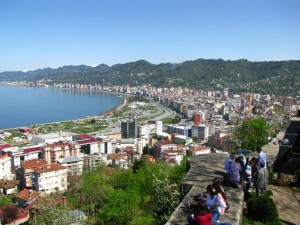
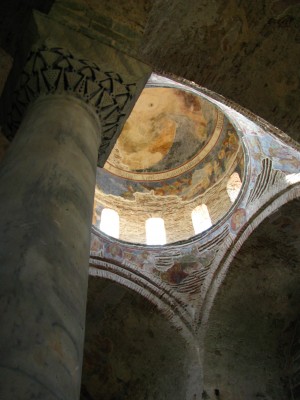
Compared to Kutaisi, Trabzon is a large and well-developed city. The downtown marketplace was packed, but the streets were well-paved, the shops were quite nice, there weren’t any beggars and basic amenities weren’t hard to find. Almost no-one spoke English, which made communication difficult since I don’t speak any Turkish, but it was surprisingly easy to make friends. We stopped for lunch at one place, and after a very difficult time trying to explain that we didn’t want any meat in our sandwiches (most of the girls in our group were vegetarian), the restaurant owner actually let us eat for free!
Some of the other volunteers had asked that we go to an American style mall, so we spent a few hours there before going to the hotel. I must confess, I was bored out of my mind. Nothing but clothes stores and Turkish fast food restaurants–it was identical to an American mall in almost every way. I suppose that that’s why the others wanted to go there–after spending a year in Georgia, they probably craved someplace that feels like home. But I’m not there yet, so that particular excursion was kind of boring.
The next day, we went up to Sumela Monastery in the mountains, and from there to Lake Uzungol. The monastery was quite cool, because it’s perched literally on the side of a cliff, almost 500 meters above the valley floor. Unfortunately, the friezes and other artwork was quite damaged, so I didn’t feel compelled to take many pictures, but it was fun to hike up there and see the view. A bunch of Turks laughed at the way I ran up the path, and the fountain at the top had some FREEZING cold mountain runoff. It was a lot of fun.
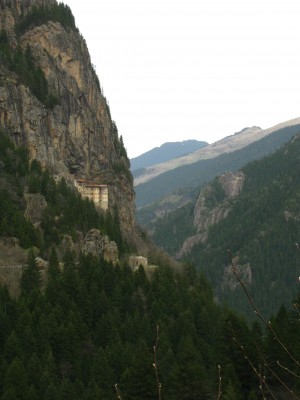
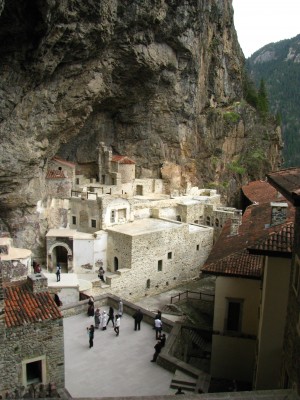
At the lake, I bought a piece of Turkish silverware for my host mom that ended up being a huge hit. A lot of the shops were really touristy, but it was fun anyway and the landscape was quite beautiful. Reminded me a bit of Colorado. We stayed in a mountain cabin and the bedsheets smelled like cigarettes, but otherwise it was quite comfortable.
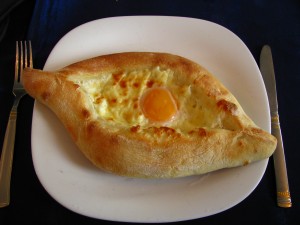
On the way back, we stopped in Batumi for dinner and had Adjaruli khatchapuri. Khatchapuri is the main Georgian go-to food–it’s basically cheesy bread with a thick, doughy crust. In Adjara, though, they take it a couple of steps further.
Immediately after taking the bread out of the oven, they crack an egg in the center, which gets cooked a little by the heat but otherwise remains raw. They then take a huge slab of butter and plop it right in the center of the yolk, where it melts in and gets everywhere. To eat it, you stir the egg around and work your way inward from the crust, dipping the bread in the molten gooey center. Between the cheese, the egg, the butter, and the bread, you get a pretty heavy meal–delicious, but heavy.
After that, we took to the road again, talking about all sorts of stuff and having a generally good time. Our tour guide was a great guy, and we had a lot of fun racking his brain. The other lady from the company was quite delightful, and talked with me a lot about Racha, growing up in Kutaisi, her experiences living in the Persian Gulf, etc. It was a long ride, but it went by pretty fast, and we pulled into Kutaisi around 9pm.
All in all, a fun, relaxing vacation, and a good chance to get out and see a little more in this part of the world. Turkey was nice, but I have to admit, I felt a bit like I was coming home when we crossed the border back into Georgia. It’s not as clean or developed, but it’s got a feel to it that isn’t quite like anything else. I like it.